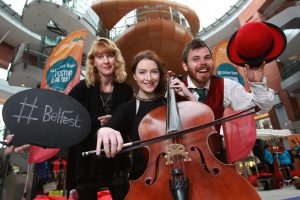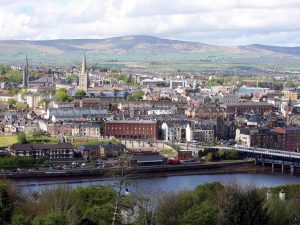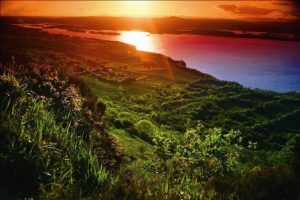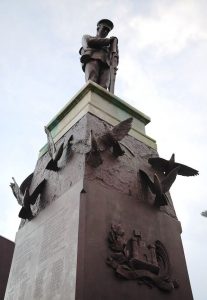
Twenty-five years since last setting his soles upon Ulster soil, Celtic Life International managing editor Stephen Patrick Clare returns to find a changed cultural, economic and political landscape. Reprinted from June 2014 edition.
BELFAST
July, 1989
After a short and scenic train ride up from Dublin – which included being strip-searched at the border (no extra cost) – I am in Belfast. The gentle mist and soft rain is a bizarre backdrop to the Troubles; soldiers and armoured vehicles roam the streets, military helicopters drone overhead, and sirens wail as local residents pass through a maze of gated checkpoints across the city core. The mood is tense, taxing, and everyone seems on edge.
March, 2014

The twenty-five minute drive from Belfast International Airport into Northern Ireland’s capital city is a revelation; it has been twenty-five years since my last visit here and – except for the gentle mist and soft rain – it is a changed country.
My first journal entry from that trip north (above) seems surreal now; gone are the guns, the soldiers, the armoured vehicles. There are no roadside checkpoints, nor blockades, nor buzz of black helicopters.
Instead, the road into town is a sea of shiny, silver SUVs, BMWs, and Mercedes. Yellow construction cranes abound, with new residential and commercial sales booming. Older homes and buildings are surrounded by red scaffolding, undergoing extensive and expensive renovations.
Pulling into Belfast, the rain is heavier, and I lurch to get my luggage into the luxurious Malmaison, one of the city’s many new high-end hotels.
Soon after, umbrella in hand, I am exploring the city, astonished by what I discover; stylish boutiques and nouveau cuisine aside refurbished pubs and churches; the boisterous Cathedral Quarter, brimming with fashionable nightclubs, just steps from the ancient Albert Memorial Clock; an array of foreign accents and financial institutions; smart phones and tablets lighting up the night.
Most impressive, perhaps, is the revamped waterfront. Once the industrial heart of global shipbuilding, and the lifeblood of the local economy, the dockyards are now home to Belfast’s booming tourism, high-tech and film industries. The magnificent, towering Titanic Museum invites visitors to peruse the past in a very present place.
As the city savours the make-over, its residents are enjoying a faith lift; the mood is light, spirited, and everyone seems energized.
The next morning, my driver picks me up. Billy Scott has lived in Belfast all of his life, and testifies to the transformation.
“I’m waiting for the other shoe to fall,” he jokes, displaying dry Irish wit. “Seriously, though, peace has brought prosperity to almost everyone here.”
As if on cue, we wind our way through a myriad of well-manicured middle-class suburbs, replete with new schools, community centers and sporting facilities.
“The standard of living has gone up significantly in a very short time,” shares Scott. “Unfortunately, so have the housing prices.
“It’s been mostly Catholic money,” he continues, quick to add that he has never taken sides. “In truth, they were the ones who stood to benefit the most from the Good Friday Accord, only because they had nowhere to go but up.”
And while the majority of Belfast’s neighbourhoods are now mixed and non-sectarian, shadows of the city’s past still lurk.
Scott steers us up past the Sandy Row, around the Crumlin Road, towards Shankill, a longstanding Protestant holdout.
 “There are always a few idiots about in places like this,” he notes, “hardliners who won’t let the past go.”
“There are always a few idiots about in places like this,” he notes, “hardliners who won’t let the past go.”
The contrast is striking; drab and decaying homes are coloured-over with massive murals and Union Jacks.
“There’s no money here anymore,” he continues. “This neigbourhood was built on the backs of shipbuilders and mill workers. For generations, there was no need for an education, because you were guaranteed a job if your dad and granddad had one. But that work is gone now.”
Just a few blocks over, in the Catholic Falls Road district, the story is similar; pro-democracy propaganda is pasted over old, broken down buildings, and barbed wire sits atop crumbling walls.
An open-top excursion bus drives by, filled with curious onlookers snapping shots.
“Political tourism,” explains Scott. “Tens of thousands of visitors now come through these communities each year. Some have roots here, others have a historical interest. Whatever the reason, it’s been good for business.”
Rebranding the Troubles has been part of the country’s efforts to reconcile its recent past.
There are still small sectarian flare-ups, however, including a skirmish the previous evening between a handful of Loyalists and Nationalists in front of City Hall as part of ongoing “flag protests”. Interestingly, though law enforcement officials were on hand, the scuffle was self-policed.
“Blame it on the booze – the bars had just let out,” laughs Scott. “But it just goes to show you that people here will step in to stop that kind of nonsense now. They aren’t willing to let anything muck with their good luck.”
GOING NORTH
July, 1989
Hitchhiking north to the coast, I catch a lift with George McGuinness, who delivers bread each day to villages between Belfast and Derry. I ask him, given the Troubles, why he continues to live here. He does not reply. He doesn’t need to. Over the coming hours, my eyes take in the breathtaking beauty of his homeland.
March, 2014
I lucked out with Ken McElroy. An author, playwright, poet, philosopher, humourist and sporting aficionado, my driver and guide for the next few days was recently awarded an MBE for his contributions to tourism. The experience is sure to be engaging, entertaining and educational.
Ken’s warmth, wit and wisdom are welcome as we weave our way through the tender Glens of Antrim. He points to this and that, regaling me with tidbits of history. The grassy knolls are peppered with small farms and streams. It is an outdoorsman’s dream, he tells me, ideal for fly fishing.
 Later, we hug the ocean on the Causeway Coastal Route, named one of the world’s top five road trips. It’s easy to see why; the seaside settings are picturesque, with a stirring view of Rathlin Island, just six miles north. Look a little farther, and the southernmost tip of Scotland’s Kintyre Peninsula comes into focus.
Later, we hug the ocean on the Causeway Coastal Route, named one of the world’s top five road trips. It’s easy to see why; the seaside settings are picturesque, with a stirring view of Rathlin Island, just six miles north. Look a little farther, and the southernmost tip of Scotland’s Kintyre Peninsula comes into focus.
The rugged Ballintoy Harbour is our first stop, one of several location sites for HBO’s hit series Game of Thrones. The parking lot is teeming with tour buses, so I sniff the salty air and take a few quick photos before we move on.
Not surprisingly, just a couple of miles west, the Giant’s Causeway is equally busy. We escape the visitor center, strolling a few hundred yards down the bluff towards the awe-inspiring seascape of hexagonal basalt columns.
As the surf pounds the shore, Ken tells me about the “Wreckers”, locals of years past who would use luring lights to deliberately steer passing ships into the rocks before looting them. The waters off Northern Ireland, he says, are among the world’s largest ocean graveyards.
An hour later, my trusted guide again brings history to life at Dunluce Castle, a now-ruined 13th century stone structure overlooking the sea. Fact is as engaging as fiction here, with stories of ghosts, Earls, Kings, Queens, Spanish sailors and two now-infamous battles between the McQuillans and the MacDonalds offering valuable insight into the region’s fascinating past.
In the town of Bushmills, home of the world famous Whiskey distillery, local residents watch travelers come and go. The four-star, 400 year-old Bushmills Inn is bustling, mostly with golfers itching to improve their handicap at the nearby 36-hole Royal Portrush Golf Club, ranked one of the top courses on the planet.
Ken theorizes on the region’s exploding popularity. “For a long time, the only news that came out of Northern Ireland was bad news, and many people have told me they were simply too afraid to come here because of the conflict.”
Later, over excellent fish ‘n’ chips and Guinness in Portballintrae, I ask him why, given the Troubles, he continued to live here. He does not reply. He doesn’t need to.
DERRY
July, 1989
Rough day in a rough part of the region. First, I am given the boots when I try to cross the street during an Orange Day Parade. Later, I am mugged by thugs in the Bogside, who walk off with my wallet and camera. Are these the trials of traveling, or merely the tribulations of not using my head? I have no one to blame but myself for the bruised body and wounded pride.
March, 2014
Ken laughs when I read him my journal entry from a quarter-century ago.
“Ah, so you didn’t use your head?” he smirks. “Well, they certainly did.”
Ha.
While my scars have since faded, my memories have not, and as we pull into the historic city of Derry – officially Londonderry – the recollections come rushing back.
Perhaps more than Belfast, Derry has come to terms with its long and difficult past, even embracing it as a vital part of its identity. History is alive and well here, carefully woven into the fabric of everyday life.
 The city was a flashpoint for the Troubles, starting in 1968 with the formation of the Northern Irish Civil Rights Association, which sought – peacefully – to improve the quality of life for area Catholics. Instead, what followed were thirty years of senseless sectarian violence and bloodshed.
The city was a flashpoint for the Troubles, starting in 1968 with the formation of the Northern Irish Civil Rights Association, which sought – peacefully – to improve the quality of life for area Catholics. Instead, what followed were thirty years of senseless sectarian violence and bloodshed.
There was fighting in the streets long before that, however, and Ken details the 1609 Plantation of Ulster, the Irish Rebellion of 1641, the 1649 Scottish Presbyterian blockade, and the Siege of 1689.
A quick visit to the multi-media Tower Museum affirms the accounts, as does a tour of the Guildhall, home of Derry’s city council and Mayor. Opened in 1890, the spectacular structure has since survived fire (1908) and two bombings (1972).
It is on the streets, however, where the past most permeates the present; the old cobblestone roads, stone mason buildings, and grand Cathedrals are all in use, as are the stoic Walls of Derry.
Built between 1614 and 1619, the historic monument is almost perfectly preserved today, providing a panoramic perspective of city. From there, I look out over the Bogside, the once impoverished community of my mother’s ancestors (Dunphys from Kerry, many of whom who came north during the famine and married local Dohertys).
Like parts of Belfast, “the Bog” has kept its murals and monuments intact, looking to prosper from political tourism. And, also like Ulster’s capital city, there are still a few hardliners here, though they are now the minority. Tellingly, the old Sinn Fein/IRA headquarters at the heart of the quarter is now an upscale Inn with a bustling bar and restaurant.
Also visible from my vantage point is the newly constructed Peace Bridge, which connects the mostly Catholic city core with the Protestant Waterside community across the River Foyle. It is a powerful image – the link is packed with pedestrians and bikers going to and fro.
Another poignant symbol, the bronze statue Hands Across The Divide by local artist Maurice Harron, stands by the bridge.
“Peace has done wonders for this place,” notes Ken. “It might seem as familiar as always, but you wouldn’t recognize it now if you tried.”
My wise guide speaks truthfully, the difference being most notable with residents, who walk with calm and confidence.
“We’ve become an international municipality,” says Mayor Martin Reilly. “Over seventy different languages can now be heard here on any given day, and we have one of the U.K.’s most thriving arts scenes.”

Named an International City of Culture in 2013, Derry is picking up where it left off last year; the list of festivals, concerts, exhibits and events scheduled for 2014 is impressive.
“There is a youthful enthusiasm here today that I have never felt before,” continues Reilly. “It is as if we have awoken from the deepest slumber – a nightmare really. And it is the young people – the artists, the entrepreneurs, the dreamers and doers – who are driving the growth.”
The numbers support the Mayor’s claim; over 71 per cent of the local population is under the age of fifty, with more than a third below the age of twenty-five.
“A lot of them are simply too young to have a full recall or understanding of the Troubles,” he adds. “Gratefully, they don’t have to live our history to learn it. And not only are they embracing our past, they are building upon it in their own manner. The scars will fade with each generation, but the memories will not.”
BORDERLANDS
July, 1989
An amazing day spent traveling through the towns of Strabane, Omagh, Enniskillen, Portadown, Armagh and Newry. The Ulster countryside is like no other, and there is as much raw physical beauty in the six counties of Northern Ireland as in the twenty-six south of the border. Hard to believe this is ‘bandit country’ – like a thorn on a rose.
March, 2014
From Derry, we head south. The sun appears and dissolves the morning mist, exposing vast pastures of farmland, rivers, and, all around us, rolling hills.
The Donegal border is less than a mile to the west. Twice we are forced to cross over into the Republic, as police and traffic block the main highway. Going over the border is a non-issue now; there are no patrols, checkpoints, or even a single sign post indicating that we have entered another country.
“Maybe there’s been an incident,” muses Ken each time.

His hesitancy is understandable. While things have changed drastically in Northern Ireland over the last fifteen years, caution is common, especially among older citizens.
En route to Enniskillen, he lists off the region’s history of horrors – bombings, shootings, knifings and kneecappings – pointing out particular locations as we pass. It is almost impossible to fathom that a land of such splendor could have known such terror.
I recall author Leon Uris once calling this land ‘A Terrible Beauty’, and perhaps nowhere is this adage more apt than in County Fermanagh, home to the lovely Lough Erne and its 154 islands. With waterways that wind more than one hundred miles, including a sizable stretch west to the Atlantic Ocean, the region is ripe with visitors year-round. Summer is especially busy, as boaters bring a boom to the local economy.
Enniskillen was also the scene of a savage IRA attack. On November 8, 1987, 11 people were killed and another 63 injured when a massive bomb detonated during the town’s Remembrance Day ceremonies. The ensuing outrage from all sides was so severe that many see the incident as a turning point in the Troubles.
A simple memorial stands in honour of those who fell.
“I don’t know anyone that wasn’t touched by the tragedy,” says Anne, who wished to remain anonymous for this story. “We were there that day. My husband and I helped carry bodies out of the rubble.”
It time, the community came together to heal.
“I was putting the laundry out to dry one morning – this was about five years after the bombing – and I started talking to my neighbor through the fence. Even though we were from different backgrounds, we quickly realized how much we shared in common.”
Within weeks the pair had set up a support group for survivors.
“It was important – no, it was essential and necessary – for us to share our thoughts and feelings about what had happened. Wounds fester in the dark, but they evaporate when exposed to the light.”
While she has not forgotten the terrible event, Anne says that she has forgiven those behind it.
“I’m not one to carry that weight around with me,” she shares softly. “After the anger fell away, the hurt set in. And then the hurt fell away.”
On the ride back to Belfast, knowing that we are soon to part ways, I ask Ken what it will take for Northern Ireland to keep the peace and prosperity.
“Time and talk,” he says thoughtfully, echoing Anne’s sentiments.
“It’s a matter of trust,” he continues. “Trust in ourselves, trust in one another, and trust in the process. Trust takes time.
“As for the talking, well that’s not a problem; after all, we’re known to have the gift of the gab.”
 Ironically, we sit in silence the rest of the way, each to our own thoughts. Back in Belfast, we bid our adieus and promise to keep in touch. And we have.
Ironically, we sit in silence the rest of the way, each to our own thoughts. Back in Belfast, we bid our adieus and promise to keep in touch. And we have.
The next morning, on the ride to the airport, I pull out my journal from 1989 and read the final entry from my previous visit here.
This most beautiful country of land and hills, lakes, sea, and sky, these most beautiful people, warm and wise, rugged, resourceful and resilient; you are in my thoughts and prayers, my head and heart, now and always. The past, present and future are yours. Choose wisely. And if, perhaps, you never change, please know that you have changed me forever. And if, perhaps, you evolve and finally find peace, please know that we have done so together. I, and the world, will be watching.
~Stephen Patrick Clare




















Leave a Comment